

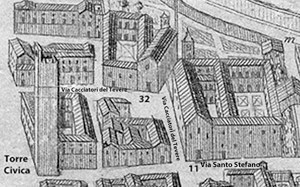
Detail from the plan (ca. 1675) of Città di Castello
by Filippo Titi (Biblioteca Comunale “Giosue Carducci”)
Bishop Pietro V allowed a group of Augustinian hermits to move to this site in 1256, soon after Pope Innocent IV had created the new Augustinian Order. Their church [11] was consecrated (or perhaps re-consecrated) in 1388.
The church and convent were badly damaged in the earthquake of 1789. The friars started to rebuild, but were expelled at the time of the French invasion (1797) and never returned.
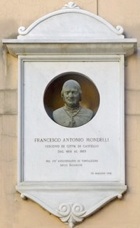
Exterior
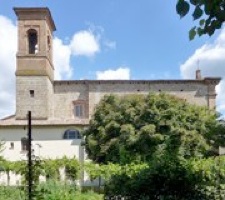
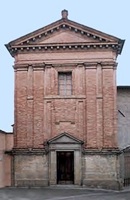
The facade of the old church was in Via Santo Stefano (as shown in the plan above). The new church was built near the site of the old campanile. Its facade is in Via Cacciatori del Tevere, immediately adjacent to the Istituto delle Salesiane.
There is a fine view of the left wall of the church and its campanile from the garden of the Istituto delle Salesiane.
Interior
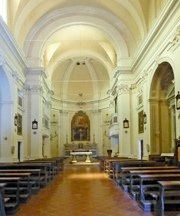
It is sometimes possible to see inside the church, thanks to the kindness of the nuns of the Istituto delle Salesiane.
Virgin intercedes for Città di Castello (ca. 1816)
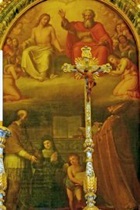
Art from Sant’ Agostino
Adoration of the Magi (1493-4)
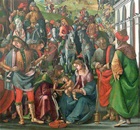
The Vitelli family probably influenced the choice of subject of the altarpiece: like the Medici and the Baglioni families, they probably identified the theme with princely patronage. The figure in a red hat and on horseback at the top right has been variously identified as Camillo, Paolo or Vitellozo Vitelli.
The altarpiece was documented on the high altar of Sant’ Agostino in 1627. This altar and its altarpiece were sold to Pope Pius VI after the earthquake of 1789. The Emperor Napoleon III acquired its main panel in the sale of the collection of the disgraced Roman collector, Giovanni Pietro Campana in 1861, and it is now in the Musée du Louvre, Paris. A panel of the Annunciation in the Philadelphia Museum of Art might have originally belonged to its predella.
Nativity (ca. 1493)
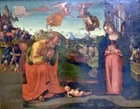
Coronation of St Nicholas of Tolentino (1500-1)
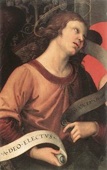
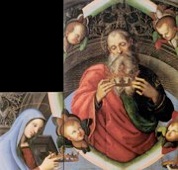
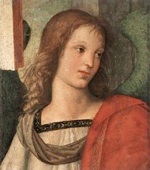
Surviving fragments at:
Pinacoteca Tosio Martinengo, Museo Nazionale di Capodimonte, Musée du Louvre,
Brescia Naples Paris
This altarpiece is almost certainly the work that the wool merchant, Andrea di Tommaso Baronci commissioned in 1500 from Raphael and Evangelista di Pian di Meleto for his chapel in Sant’ Agostino, and for which he paid on its completion in 1501. If the link between the altarpiece and the documents is correct, this was Raphael’s earliest documented work. Despite the fact that he was only seventeen, he was termed "magister" in the contract, and named before his older collaborator. This suggests that he had already matriculated and that he was by this time the senior of the two, at least in the context of this commission. In view of his age, the goldsmith Battista di Florido acted as guarantor for him: Batista’s son, an artist who became known as Francesco Tifernate, was greatly influenced by Raphael’s work in the city.
The altarpiece was (like the church itself) in an earthquake in 1789. The then-owners of the chapel, who had obstructed plans to sell it in 1788, now agreed to the sale of what remained in order help rebuild the church.
-
✴Pope Pius VI acquired the four surviving fragments from the upper part of the main panel. There were looted during the French occupation of Rome in 1798 and subsequently dispersed. They are illustrated above, with captions that indicate their respective current locations.
-
✴Two predella panels depicting miracles of St Nicholas of Tolentino, which might have belonged to this altarpiece or alternatively to the Capra Altarpiece by Perugino, found their way into the collection of Ralph Harman Booth (died 1931). His widow gave them to the Institute of Arts, Detroit, and they are illustrated in the institute's website.
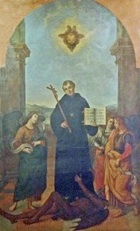
-
✴Preparatory sketches for it survive in the Musée des Beaux Arts, Lille and the Ashmolean Museum, Oxford.
-
✴Ermenegildo Costantini, who was working in the Duomo at the time of the earthquake and who subsequently fled to Rome, painted a loose copy of its lower part in 1791. This is now in the Pinacoteca Comunale (illustrated here).
-
✴Luigi Lanzi gave a description of it in a book that was published in 1795.
From these clues, it can be established that:
-
✴St Nicholas of Tolentino stood on a prostrate figure of Satan in the centre of the lower part of the composition;
-
✴there were probably two angels to each side of him (fragments of two of which survive); and
-
✴the upper part of the work contained three figures, each of which held a crown:
-
•God the Father in a mandorla, with a half-length figure of the Virgin to the left (now seen in the third surviving fragment); and
-
•a lost figure of St Augustine to the right, which balanced the figure of the Virgin.
It is clear from the size of the figures that survive that the original altarpiece must have been huge.
Vision of St Jerome (1527)
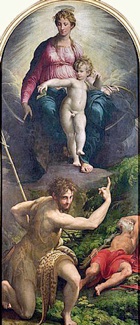
Massacre of the Innocents (1570-1)
Surviving documents record that Pompeo Tiberti commissioned this altarpiece from Nicolò Circignani, il Pomarancio in 1570, and that its price was agreed after its completion in the following year. The local art historian Giacomo Mancini reported that, during an apostolic visit in 1571, Monsignor Paolo delle Rovere tried unsuccessfully to prevent its exposure in the church because of the “obscene nudity of some of the figures”. It survived the earthquake of 1789 and the depredations of French soldiers in 1798, and was still in place in 1807, when the friars sold it to Mancini himself. This iss probably the panel that is now in the Galleria Nazionale d’ Arte Antica, Palazzo Barberini, Rome, which has recently been restored.

